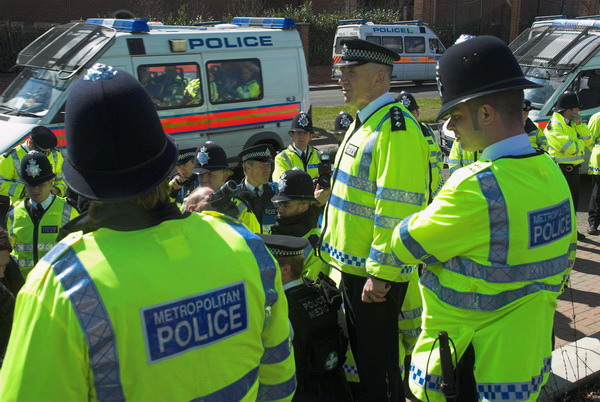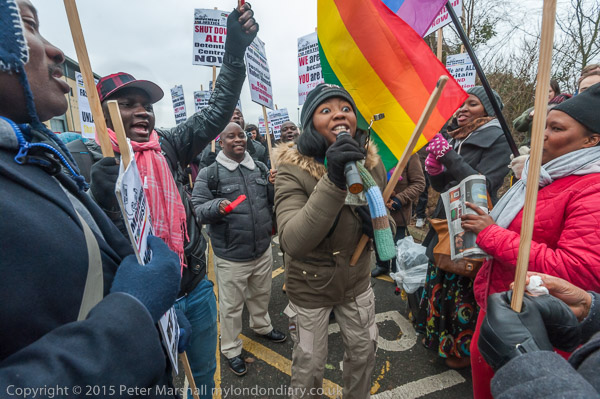It was back in 2006 that I first went to photograph a protest outside the Harmondsworth and Colnbrook immigration detention centres, just to the north of London’s Heathrow airport. It’s an occasion I remember for several reasons. Perhaps most strongly the intense shame that I felt listening to some of those held inside speaking about how badly they were being treated – they were able to speak from inside on mobile phones, with their voices then amplified by holding a microphone to a phone at the protest outside the prisons. I was ashamed that my country, which often prides itself on democracy, freedom and the rule of law was clearly behaving in such a clearly racist and unlawful manner – and then it was under a government of a party I had voted for, the party I had until then supported all of my life.

It was a protest with a strong police presence, with lots of barriers, and at one point a number of protesters who had walked down a public footpath to protest at one side of the site were surrounded by police and brought back to the main road outside. I stood on an earth bank with a couple of other photographers and photographed them, looking down.
One videographer was being held by the police inside the kettle (just visible between the uniforms above), and was showing his press card asking to be let out. But the police told him that it wasn’t a proper press card. Despite the statement on the back “The Association of Chief Police Officers of England, Wales and Northern Ireland and the Association of Chief Police Officers in Scotland recognise the holder of this card as a bona fide newsgatherer” and a verification phone number, the police simply refused to acknowledge it. This was not at the time unusual, and it still happens now despite a long campaign.
The videographer appealed to the three of us for help, asking us to show them what a press card looked like to verify that his was genuine. It left me in a slightly awkward position, as when I arrived at the protest I’d noticed that my own press card had expired at the end of the previous month, and had got through the police line to take pictures with my thumb holding it by the corner so it covered the expiry date. Fortunately one of those next to me went and showed his card, and eventually after some further persuasion the officers released the man from the kettle. The protesters were less fortunate, and were held until the end of the protest before being forced to give their names and addresses or be arrested, and were then escorted to their coach.
UK Press cards are issued by a number of bodies, including my union, the NUJ, acting for the UK Press Card Authority and there are continuing arguments about exactly who should qualify for them. I seldom take mine out of my pocket when working, but there are a few occasions when I need it access press areas or leave events through police lines without one. That doesn’t always work, though usually when one officer refuses to let me through I’ve simply walked a few yards down the line and tried again with success, only occasionally having to appeal to a more senior officer. I also wear it visibily on a few occasions where I think it will reassure the people I’m photographing – particularly at events involving children. But for the great majority of events it stays in my pocket, tied in a holder with a cord around my belt for security.

Protesters march up the drive towards the detention centre
I had a little argument with the security guards at the start of the protest Surround Harmondsworth 6 the latest in a new series of protests at Harmondsworth & Colnbrook (this year brought together under new private management and renamed Heathrow) when they tried to push me inside the barriers with the protesters. Eventually we came to an arrangement that suited me, but I wanted to make the point for myself and the other photographer and TV crew that enabled us to work as we wanted. I did mainly want to photograph inside with the protesters, but I don’t like being pushed around and wanted to take some pictures of the banners draped in front of them on the barriers.

There were really few photographic problems, though some of the stories from protesters who had previously been held in Harmondsworth or other detention centres of their treatment were shameful, and at one point I was working through tears steaming up my glasses making using the viewfinder difficult. Fortunately autofocus works even if you can’t see the image clearly. But this was an emotional protest for those taking part and for me. I hope it shows in some of the pictures.
As usual at these protests there was a great deal of noise, and also a lot of dancing and movement. Although security and police kept the protesters to the front of the site, well away from the detention blocks, those inside were able to hear us, letting people know by phone, and thanking the protesters for coming.

16-35mm, 16mm
Working in the middle of the protesters, wide-angle lenses were often needed, and many of the pictures were taken at the wider end of the 16-35mm, and some too with the 16mm fisheye. As usual these were later processed with the Fisheye-Hemi plugin to give the less distracting cylindrical perspective. For images of people it produces a more normal result than an extreme wide rectilinear lens, where the elongation at edges and corners can seem very odd. It often gets noticeable at 16mm, but really gets objectionable in many images if I use the even wider 12-24mm Sigma – which although it covers the full frame is better used as a DX lens. The Nikon 16-35mm, with a similar range of focal lengths on FX to the Sigma on DX is also a sharper lens, so there is really little point in my ever using the Sigma.

16mm, Fisheye-Hemi
I prefer to use the 16mm fisheye on the D700, usually keeping the 18-105mm DX on the D800E. The reason is file size, as using the Fisheye-Hemi plug in generates a 16 bit ProPhoto RGB Tiff file with 6 bytes per pixel from the Nikon NEF file. With the 12Mp D700 (typically giving NEF files compressed to around 12Mb) this ends up at around 70Mb.

16-35mm, 18mm
As I write this, a month after Surround Harmondsworth 6, protests are taking place inside this and other detention centres, and there are a number of more spontaneous protests with groups arriving unannounced to protest outside. A number of aspects of the treatment of asylum seekers have been found to be illegal, and a parliamentary has called for changes. Inside the centres, the legal niceties and human rights continue to be abused, but there is certainly now some hope of real change, thanks largely to the publicity generated by protests inside and outside these immigration prisons.
______________________________________________________
My London Diary : Buildings of London : River Lea/Lee Valley : London’s Industrial Heritage
All photographs on this and my other sites, unless otherwise stated, are taken by and copyright of Peter Marshall, and are available for reproduction or can be bought as prints.
To order prints or reproduce images
________________________________________________________
One thought on “Surround Harmondsworth 6”